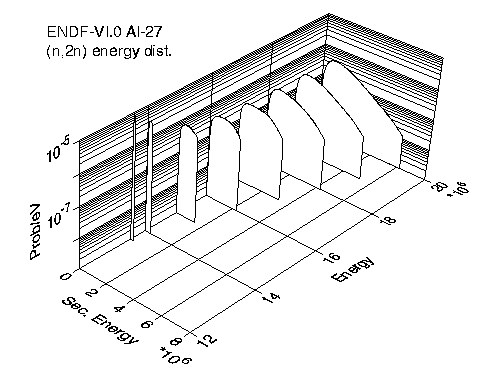File 5 allows for several different representations of the spectra of outgoing neutrons:
LF=1, Arbitrary tabulation function: A set of incident energies is given, and a normalized tabulated distribution is given at each incident energy. This option is very general, and it is the modern choice for detailed fission spectra, such as those produced with the Los Alamos Standard Model.
LF=5, General evaporation spectrum: Here a temperature-like quantity θ is tabulated against incident energy E, and a single spectrum is given as a function of E'/θ. The only current application for this law is to give six different delayed-neutron spectra for six time groups, and θ is just set to one. See MF=5, MT=455 in fissionable materials.
LF=7, Simple Maxwellian fission spectrum: This is a fairly old model for the distribution of neutrons emitted by fission, but it is still in fairly wide use. The effective temperature θ is tabulated against the incident energy E, and the range of final energies allowed is from zero to E-U.
LF=9, Evaporation spectrum: This is the kind of shape that would be expected if the the compound nucleus during a reaction had lots of time to come into equilibrium before the neutron was emitted, and it may not be a bad approximation for fairly low incident energies (a few MeV). At higher energies, preequilibrium emission begins to change the shape away from the evaporation form, but this is also the region where energy-angle correlation begins to be important. Once again, the effective temperature of the compound system θ is tabulated against the incident energy E, and the range of final energies allowed is from zero to E-U.
LF=11, Energy-dependent Watt spectrum: The Watt spectrum is a more sophisticated representation of fission than the simple Maxwellian law described above. Two functions a(E) and b(E) are tabulated in File 5, and the range of final energies allowed is from zero to E-U.
LF=12, Madland-Nix fission spectrum: This is another sophisticated fission model based on two constants EFL and EFM, the average kinetic energies of the light and heavy fragments, respectively, and a temperature-like quantity TM that is given as a function of incident energy E.
The following is an example of a tabulated distribution (LF=1) from File 5 for the 27Al(n,2n) reaction from ENDF/B-VI Release 0:
